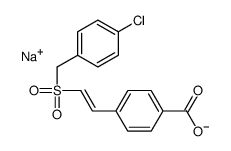All AbMole products are for research use only, cannot be used for human consumption.

Recilisib (ON 01210) sodium is a radioprotectant, which can activate AKT, PI3K activities in cells. Recilisib Sodium (up to 50 µM) shows a normal distribution of cells throughout the cell cycle, with a slight reduction in the number of cells in S-phase at 50 µM. Recilisib Sodium provides dose dependent protection of human bone marrow cells at all three doses of IR. Recilisib Sodium activates the phosphorylation of AKT and GSK3α/β in HFL cells. Recilisib Sodium increases PI3K activity in HFL-1 cells and murine bone marrow cells in response to radiation exposure. Recilisib Sodium treatment in combination with radiation alters the MAPK signaling pathway.
In vivo, Recilisib Sodium (500 mg/kg) significantly increases the rate of recovery and differentiation of primitive bone marrow myeloid progenitor cells in mice. Recilisib Sodium in combination with radiation reduces CFU numbers in mice, but the Recilisib Sodium-treated mice consistently retain a capability to form differentiated colonies.

Int Immunopharmacol. 2023 Oct 17;124(Pt B):111063.
Effects of the PI3K/Akt/HO-1 pathway on autophagy in a sepsis-induced acute lung injury mouse model
Recilisib sodium purchased from AbMole
| Molecular Weight | 358.77 |
| Formula | C16H12ClNaO4S |
| CAS Number | 922139-31-9 |
| Solubility (25°C) | DMSO 30 mg/mL |
| Storage |
Powder -20°C 3 years ; 4°C 2 years In solvent -80°C 6 months ; -20°C 1 month |
| Related Akt Products |
|---|
| ZINC00784494
ZINC00784494 is a specific Lipocalin-2 (LCN2) inhibitor. ZINC00784494 inhibits cell proliferation, cell viability and reduces AKT phosphorylation levels in SUM149 cells. |
| (E)-Akt inhibitor-IV
(E)-Akt inhibitor-IV is a PI3K-Akt inhibitor, with potent cytotoxic. |
| K-80003
K-80003 is a potent inhibitor of tRXRα-dependent Akt activation and cancer cell growth. |
| FPA-124
FPA-124, a cell-permeable copper complex, is a selective Akt inhibitor with an IC50 of 0.1 μM. |
| SPOP-IN-1
SPOP-IN-1 is a selective SPOP E3 ubiquitin ligase inhibitor. |
All AbMole products are for research use only, cannot be used for human consumption or veterinary use. We do not provide products or services to individuals. Please comply with the intended use and do not use AbMole products for any other purpose.


Products are for research use only. Not for human use. We do not sell to patients.
© Copyright 2010-2024 AbMole BioScience. All Rights Reserved.
